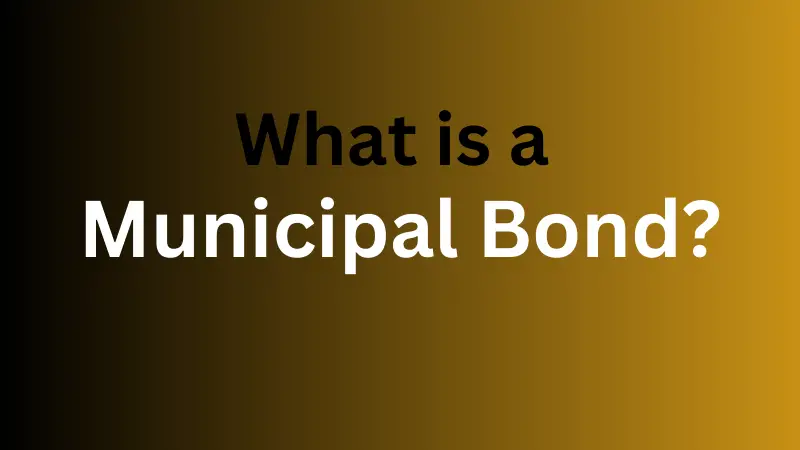What is a Municipal Bond?

A municipal bond is a type of bond issued by state or local governments or their agencies to raise funds for public projects such as schools, hospitals, highways, or other infrastructure developments. Municipal bonds are also known as “munis” and they are debt securities that investors can purchase to lend money to the government.
How Do Municipal Bonds Work?
Municipal bonds work in a similar way to other types of bonds. When a state or local government needs to raise funds for a public project, they issue bonds that investors can purchase. In return for buying these bonds, investors receive interest payments at regular intervals, typically semi-annually, until the bonds mature.
When a municipal bond reaches its maturity date, the government entity that issued the bond will repay the principal amount to the bondholder. Municipal bonds can have maturities ranging from a few months to 30 years or more, depending on the needs of the issuer.
Municipal bonds can be issued in two ways: through a competitive bidding process or through negotiation with an underwriting firm. In a competitive bidding process, multiple underwriters compete to purchase the bonds from the issuer and then resell them to investors. In a negotiated sale, the issuer works directly with an underwriting firm to set the terms of the bond offering.
The interest rate on a municipal bond is based on a number of factors, including the creditworthiness of the issuer, the length of the bond’s maturity, and the prevailing interest rates in the market. Municipal bonds are typically rated by credit rating agencies, which assess the creditworthiness of the issuer and assign a rating based on their analysis.
Brief History of Municipal Bonds
The history of municipal bonds can be traced back to the early 1800s in the United States. As cities and towns grew in size and population, they began to require funding for public projects such as schools, hospitals, and infrastructure developments. Municipalities began issuing bonds to raise the necessary funds, and the use of municipal bonds quickly spread throughout the country.
First recorded Municipal bond
The first Municipal bond was a general obligation bond issued by the City of New York in 1812. During the 1840s, many U.S. cities were in debt, and by 1843 cities had roughly $25 million in outstanding debt. This debt was used to finance both urban improvements and a growing system of public education.
In the decades that followed
The use of municipal bonds continued to grow as more and more cities and towns issued bonds to fund a wide range of projects. During the Great Depression, the federal government established the Public Works Administration and other agencies to provide funding for public works projects, and municipal bonds played a major role in financing these projects.
In the post-World War II era
Municipal bonds continued to be an important source of funding for public projects, and their popularity grew as investors sought tax-exempt income.
Today
Municipal bonds remain an important part of the financial landscape, with billions of dollars in new issuances each year.
Types of Municipal Bonds
There are several types of municipal bonds, each with its own unique characteristics, benefits, and risks. The main types of municipal bonds are:
- General obligation bonds: These bonds are backed by the full faith and credit of the issuer, which means that the issuer is obligated to repay the bondholders regardless of the specific project or revenue source being financed by the bond. General obligation bonds are typically considered to be the safest type of municipal bond.
- Revenue bonds: These bonds are backed by the revenue generated by a specific project, such as a toll road or a water treatment plant. The revenue stream is used to repay the bondholders, and the creditworthiness of the bond depends on the success of the project and the ability of the revenue source to generate sufficient income.
- Industrial development bonds: These bonds are issued to finance projects that promote economic development, such as the construction of a new factory or the expansion of an existing business. Industrial development bonds may be backed by the full faith and credit of the issuer or by the revenue generated by the project.
- Housing bonds: These bonds are issued to finance the construction or rehabilitation of affordable housing units. Housing bonds may be backed by the full faith and credit of the issuer or by the revenue generated by the project.
- Tax anticipation notes: These are short-term bonds that are issued to fund short-term cash flow needs. They are typically repaid when the issuer receives its tax revenues.
- Municipal zero coupon bonds: These bonds are sold at a discount to their face value and do not pay interest. Instead, the bondholder receives the full face value of the bond when it matures. Zero coupon bonds are often used for long-term investments or for funding future obligations, such as pension liabilities.
- Variable rate demand bonds: These bonds have interest rates that adjust periodically based on a benchmark rate, such as the London Interbank Offered Rate (LIBOR). Variable-rate demand bonds are often used by issuers who want to take advantage of changing interest rates or who need flexibility in managing their debt.
Advantages and Disadvantages
Municipal bonds offer several advantages and disadvantages to investors, which include:
Advantages:
- Municipal bond interest is often exempt from federal income tax and, in some cases, state and local taxes, which can make them more attractive to investors in higher tax brackets.
- Municipal bonds are generally considered to be safe investments because they are backed by the taxing power of the government entity that issues them.
- Municipal bonds pay interest at regular intervals, typically semi-annually, providing investors with a steady source of income.
- Municipal bonds can provide diversification for investors who may already have a significant allocation to stocks or other asset classes.
- Municipal bonds can be used to support socially responsible investing by providing funding for public projects such as schools, hospitals, and other infrastructure developments.
Disadvantages:
- Municipal bonds generally offer lower returns than corporate bonds with similar risk profiles, which may make them less attractive to some investors.
- The value of a municipal bond can be affected by changes in interest rates, which can lead to price volatility.
- Municipal bonds are not without risk, and the creditworthiness of the issuer can impact the bond’s value. Bonds issued by lower-rated issuers may be at higher risk of default.
- Municipal bonds may be less liquid than other investments, meaning that they may be difficult to sell if an investor needs to raise cash quickly.
- Municipal bonds can be complex investments, and understanding the tax implications and credit risk involved can require a significant amount of research and expertise.
How to Invest in Municipal Bonds?
Investing in municipal bonds can be a good way to diversify your portfolio and generate steady income. Here are some steps to get started:
Educate yourself
Before investing in municipal bonds, it’s important to understand how they work, the risks and benefits, and how to evaluate individual bond offerings. You can read books, attend seminars, or consult with a financial advisor to learn more about municipal bonds.
Open a brokerage account
To invest in municipal bonds, you’ll need to open a brokerage account with a financial institution that offers municipal bonds. Many online brokerages offer a range of municipal bond offerings.
Determine your investment objectives
Consider your investment objectives, risk tolerance, and time horizon to determine what type of municipal bonds are best suited for your needs.
Research individual bond offerings
Research individual bond offerings to find those that meet your investment objectives. You can find information on bond offerings from sources such as the Municipal Securities Rulemaking Board’s Electronic Municipal Market Access (EMMA) website, as well as from brokerage firms and financial advisors.
Place an order
Once you’ve found a bond offering that meets your investment objectives, you can place an order through your brokerage account. Your broker will execute the trade on your behalf, and you will receive periodic interest payments and the return of your principal when the bond matures.
How Much Money to Start With?
The amount of money needed to invest in municipal bonds varies depending on the specific bond offering and the requirements of the issuing entity. Municipal bonds are typically issued in minimum denominations of $5,000, although some bonds may have higher minimum denominations.
In general, investors may need to purchase at least one bond, which can cost anywhere from a few thousand to several hundred thousand dollars. The actual amount required to invest in municipal bonds will depend on the individual investor’s financial situation, investment goals, and the availability of bond offerings in the market.
How Much Interest Can Be Made From Municipal Bonds?
The amount of interest paid by municipal bonds can vary between 1% to 5% annually depending on a number of factors, including the creditworthiness of the issuer, the maturity of the bond, and the prevailing interest rates in the market. Generally speaking, municipal bonds offer lower interest rates than corporate bonds with similar risk profiles, but they may be more attractive to investors in higher tax brackets because of their tax-exempt status.
The interest rate on a municipal bond is typically expressed as a percentage of the bond’s face value or par value. For example, a $10,000 municipal bond with a 5% interest rate would pay $500 in annual interest to the bondholder. Municipal bonds typically pay interest semi-annually, meaning that the bondholder would receive two payments of $250 each over the course of the year. General on June 30th and December 31st of each year.
The exact interest rate offered by a municipal bond will depend on a variety of factors, including the creditworthiness of the issuer and the length of the bond’s maturity. Municipal bonds issued by higher-rated issuers, such as states or large municipalities, may offer lower interest rates than bonds issued by smaller or lower-rated issuers. Additionally, longer-term bonds may offer higher interest rates than shorter-term bonds to compensate investors for the additional risk and the impact of inflation over time.
Conclusion
Investing in municipal bonds can be a great way to diversify your portfolio and earn a steady stream of income. However, there are some risks involved. Investors should carefully consider their investment objectives and risk tolerance before investing in any municipal bond. Investors are also encouraged to seek out Professional Financial advisors who have experience in Munis.


